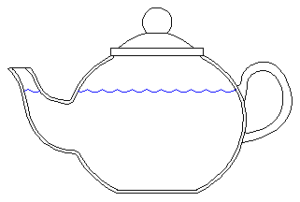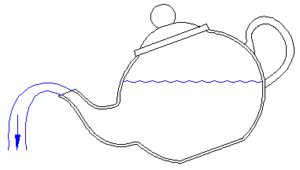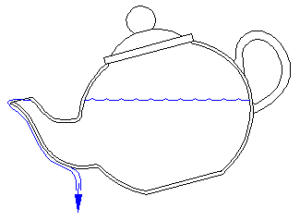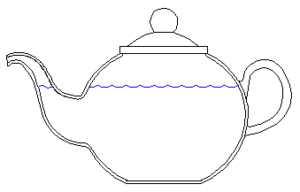For nearly 100 years PID controllers have been the standard for feedback control of a wide range of processes including autopilots, automotive cruise control, industrial heating, servo positioning, and motor speed control. PID stands for Proportional-Integral-Derivative, also called Span-Reset-Rate in earlier times. The PID controller reads the process variable, PV, such as temperature or position to be controlled. The value is compared to a setpoint, SP, and use to calculate a control variable, CV, such as heater power or motor voltage to drive the process toward the setpoint. PID controllers are “tuned” by adjusting three internal constants. Ideally the tuning should allow close control of the process. A properly tuned controller should bring the process up to the desired setpoint quickly and settle smoothly to the desired value without overshoot. A controller that is too aggressively tuned will slew the process too hard and overshoot, then try to bring that process back, undershooting, and continue to oscillate around the setpoint. A controller that is too conservatively tuned will react sluggishly and slowly approach the desired value, perhaps never reaching it.
PID works well for ordinary processes but has a problem controlling processes with a significant delay compared to the process response time constant. An exotic example would be a remotely controlled lunar rover. It may be able to turn in 1 second but nothing will be seen for 3 seconds and any error will take 3 seconds to change. Imagine a simple earth based direction control where the rover hunts back and forth around the desired direction, tacking one way for 3 seconds and then the other for 3 seconds. If a standard PID controller is tuned conservatively enough to eliminate the hunting it will be very sluggish compared to the potential speed of the overall controlled process. A more familiar example is adjusting a bathroom shower. If it’s too cold you turn down the cold faucet, but nothing happens for few seconds. If you keep turning the cold down while waiting the water will end up too hot. Then you start turning the cold back up and when the water at the shower head hits the right temperature it is already too cold coming up the pipe. The problem here is that the temperature can be changed much faster than you can find out about it. A human quickly hits upon the solution: make a small adjustment, wait a bit, make another small adjustment, wait, and repeat until the temperature is correct.
Modern computerized process control uses strategies such as the Smith predictor which uses a mathematical model of the process to predict in advance what the process will do after the delay or System Inversion which uses a model of both the process and the controller for an improved future prediction. These require a priori mathematical computer models of the process and controller.
Long before such sophistication existed there was a surprisingly robust technique called chopped or pulsed PID. This basically emulates the human shower algorithm by chopping the PID controller on and off repeatedly. This is still useful when a simpler solution is desired or when there is limited knowledge of the process model, as is usually the case.
The PID is first turned on briefly. While ON the PID operates normally, driving the process toward the desired result.
The PID control is then turned off for a time approximating the process delay. While OFF the proportional and derivative terms sample the error normally but have no other effect beyond keeping track of the rate of change. If the integral gain is nonzero, the internal integral term is held unchanged. If the process is integrating such as position control, the control variable is turned off (zeroed) while the PID is off. If the process is a normal lag such as temperature or speed control, the control variable is held unchanged while the PID is off.
This adds two more constants to the existing three for PID. The off time should approximate the delay, longer is more conservative, shorter is more aggressive. An on time less than the process time constant exclusive of delay is more conservative and longer is less conservative. Neither is particularly critical and the control scheme is quite robust. When tuned properly, chopped PID responds and settles much more quickly and stably than standard PID for a process with delay.
Processes that involve pure delay include: fluid flow in pipes where the source is heated or cooled but the pipe outlet temperature is sensed, speed of light delay for control of satellites, pneumatic instrumentation and control systems where small pressure changes have to propagate through long thin tubes, and control over computer networks where there can be significant processing and/or communication delays.






 When my great-grandfather needed to warm his farmhouse, he would cut down a tree, chop it into firewood, and carry a portion back to put in the fireplace. If he ever wondered about future generations automating that chore, he might have imagined a mechanical man performing a similar task, much like the Tin Woodsman from The Wizard of Oz. He could not have imagined that his grandchildren would warm and cool their homes with the turn of a dial, taking advantage of technology and infrastructure that are inevitable only in hindsight.
When my great-grandfather needed to warm his farmhouse, he would cut down a tree, chop it into firewood, and carry a portion back to put in the fireplace. If he ever wondered about future generations automating that chore, he might have imagined a mechanical man performing a similar task, much like the Tin Woodsman from The Wizard of Oz. He could not have imagined that his grandchildren would warm and cool their homes with the turn of a dial, taking advantage of technology and infrastructure that are inevitable only in hindsight.